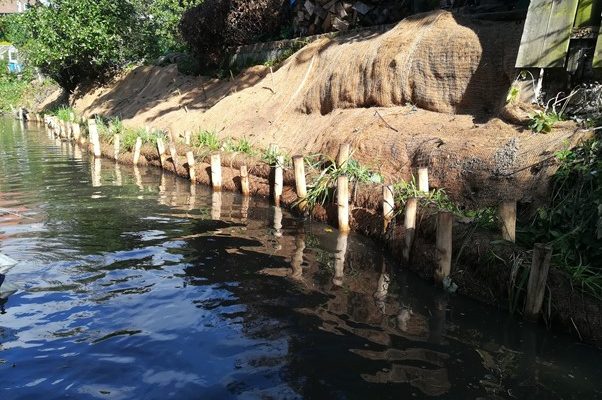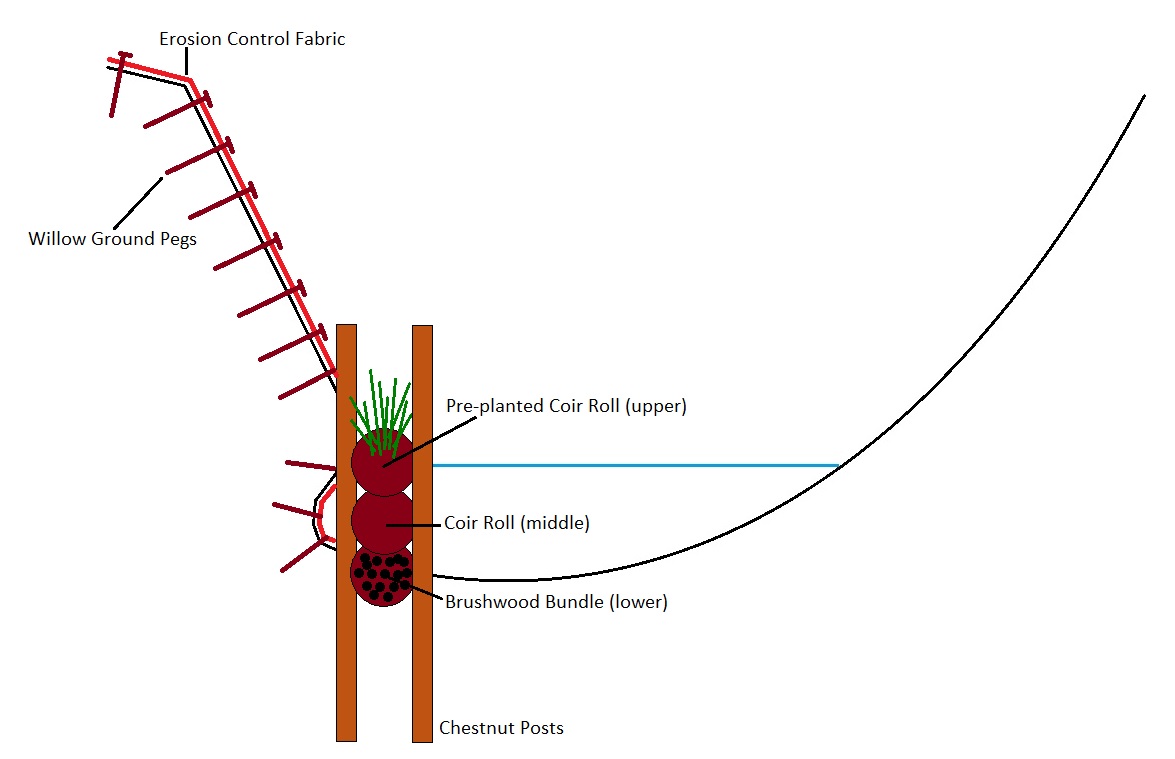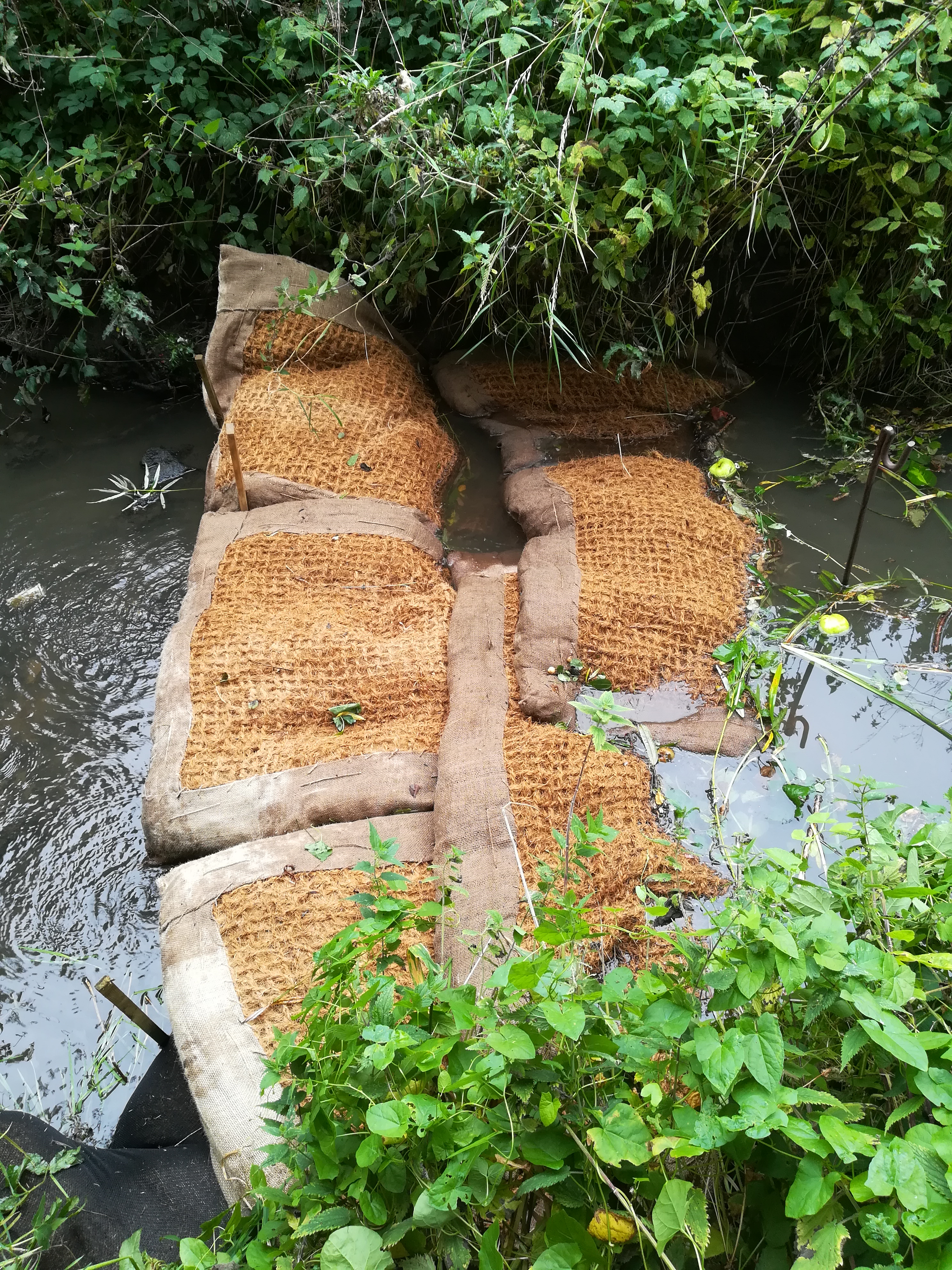During the summer of 2021, EcoNorth was presented with the challenge of designing and installing an erosion protection system, using natural materials, for an ever receding riverbank at the end of a resident’s garden. Although the rate of erosion from the watercourse was not observable over a weekly or monthly basis, several metres of the garden had been lost over the previous three decades.
EcoNorth staff conducted a scoping site visit shortly after the initial enquiry, wherein it became apparent that several attempts to support the 20m stretch of riverbank had been tried in previous years. A plethora of construction materials (including timber panelling, brick, mortar, breeze blocks, glass bottles and concrete) were all partially exposed and beneath a small brick wall, which was beginning to lean worrying toward the river.
Willow spiling is the weaving of live willow rods to create a living erosion control barrier. It was proposed as a solution to diminish the rate of scour and bank undermining. Although willow spiling is a tried and tested natural technique, it is a seasonal activity and can only be completed from late autumn to early spring when willow species are dormant. Our subsequent consultation with the Environment Agency identified that the watercourse was a known winter migration route for spawning salmon and salmonids, which directly conflicted with the willow spiling period.
Back to the drawing board we went, to consider an alternative and ecologically sound solution which also suited the client’s budget. Subject to the presence of migrating fish, and as the proposal concerned a statutory main river, the alternative solution was constrained by the conditions of a Standard Rule 2015 No.33 permit (relating to works that require the repair and protection of up to 20m of a main riverbank using natural materials (https://www.gov.uk/government/collections/standard-rules-environmental-permitting).
EcoNorth’s second proposal included the installation of a multi-tier coir roll revetment combined with an erosion control fabric, all of naturally derived and biodegradable materials (i.e. hessian and coco husk fibers). Three different options were proposed, each with a fixed fee breakdown and a works plan.
Shortly after EcoNorth’s submission of the standard rules permit application and a supporting precautionary method statement, the client was issued with the necessary approval to conduct the works. The method statement contained, as a minimum, a pre-works survey to take into consideration for otter and water vole, which are protected under Schedule 5 of the Wildlife and Countryside Act 1981 (as amended), with measures to prevent the spread of any invasive and non-native species listed as Schedule 9 under the Act, as well as biosecurity actions to avoid the potential transmission of water borne pathogens.
- Days 1-2: Extended site walkover and pre-works survey for protected/notable species and invasive species. Installation of a temporary downstream silt barrier (silt wattles and silt mats were secured perpendicular to the channel using chestnut stakes and rebar pins) to minimise downstream sediment release and turbidity. Riverbank vegetation was cleared using hand tools – existing shrubs and tree saplings were retained where possible. The first row of chestnut stakes were driven into the bank toe with a 1m spacing.
- Days 2-3: Installation of the erosion control Bionet C125NB across the bank face (pre-rolled 2.4m x 35m). In an ideal world the net would be secured at the bank top within a backfilled trench, with chestnut ground pegs across the bank face. In this case, the bank top was capped by a short brick wall, and so the net was secured using rows of willow pegs, made using willow already present at the site.
- Days 3-4: Installation of the retaining row of chestnut stakes followed by securing the brushwood bundle to protection tier 1. These brushwood bundles help to deflect and the reduce the flow rate of the channel at the base of the bank, leading to a reduction in the toe scour and an increase in deposition. Schematic of the erosion control system and temporary sediment barrier to prevent downstream sediment release and turbidity. This was followed by a small amount of backfilling behind tier 1 using local earth and the installation of unplanted coir rolls (tier 2).
- Day 4: Installation of the pre-planted coir rolls (tier 30). The planted coir rolls had been matured in a wetland nursery and will rapidly establish a root network through the tier system. Early root growth was noticed in the days following their delivery (despite being stored in the garden and watered daily with the garden hose). Once securely tied down and the final checks were completed, the temporary silt barrier was removed. The barrier was placed at the bank top to drain until dry (and a little lighter!).
The wood fibres found in the silt wattles were applied as mulch within the garden, and the silt mats were laid down amongst the shrubs as a short-term weed suppressant and a fertiliser.
Our timing could not have been better – two weeks later the watercourse had flooded after several days of heavy rainfall. The watercourse had risen over one metre and was lapping at the base of the brick wall on the bank top. This was a brilliant test of the erosion control system. We are excited to see how the system establishes in the years to come and what wildlife it attracts!



